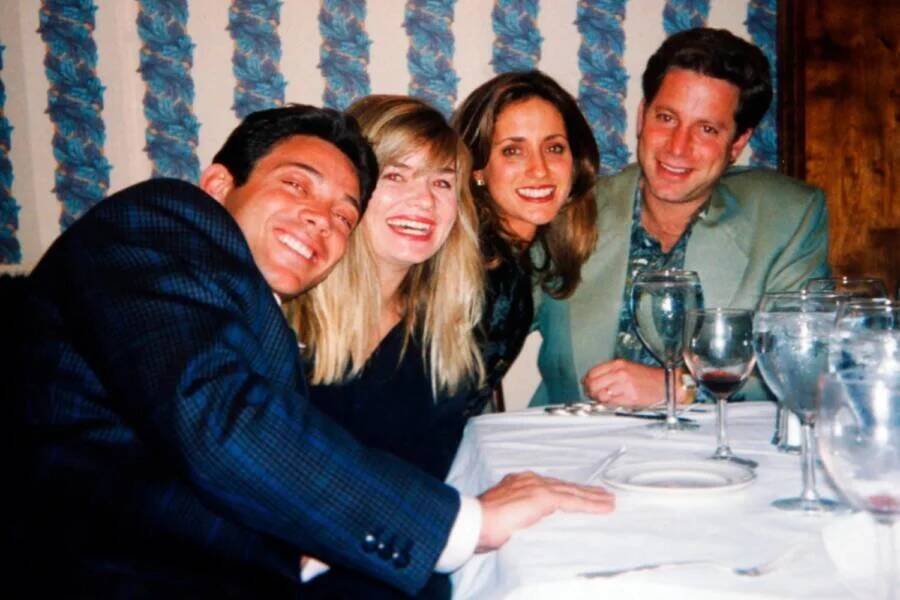The founder of the brokerage firm Stratton Oakmont, Jordan Belfort made millions of dollars through his illegal “pump and dump” schemes — and spent it all on things like sports cars, lavish parties, and drugs.

Sash Alexander/Alamy Stock PhotoJordan Belfort, the real-life “Wolf of Wall Street.”
Jordan Belfort is best known as the “Wolf of Wall Street,” though many also call him a conman. Back in the late 1980s and early 1990s, Belfort rose to prominence on Wall Street thanks to his brokerage firm, Stratton Oakmont, which ran an elaborate “pump and dump” scheme that defrauded investors of more than $110 million.
Before the FBI took Stratton Oakmont down, however, Belfort was riding high. He spent his fortune on a lavish mansion, expensive cars, a massive yacht, and copious amounts of drugs. Belfort became infamous for his party animal lifestyle — but it came with a price.
Jordan Belfort’s personal relationships suffered greatly. He cheated on his first wife with his second and then cheated on her with several other women. He became paranoid and afraid that someone would come along and steal away everything he had worked for. Eventually, the authorities caught onto him — and when they did, Belfort showed his true colors. He became an informant and sold out his former business partners in exchange for a lesser sentence.
In the end, though, it has proven difficult to keep the real Wolf of Wall Street down. To this day, he’s still running a business and is frequently booked for speaking engagements, especially in the wake of his 2007 memoir aptly titled The Wolf of Wall Street and the 2013 Martin Scorsese film of the same name.
Jordan Belfort’s Humble Beginnings
Jordan Belfort wasn’t always the real-life Wolf of Wall Street. Before he was one of New York’s most infamous fraudsters, Belfort was a young Jewish kid growing up in Queens in the 1960s. He always had a keen eye — if not for business, then surely for ways to make money.
During the summers, he would “hustle Italian ices blanket-to-blanket, and make a fortune,” according to Belfort’s own memoir. By his estimation, he made $20,000 every year selling treats on the beach, a skill that would no doubt help him in the future.
After graduating from high school, Belfort went on to attend American University, earning a degree in biology with plans to attend dental school. He then enrolled in the University of Maryland School of Dentistry only to have his dreams crushed by brutal reality.
On the first day, Belfort wrote, “the dean got up before the incoming class and explained how the Golden Age of Dentistry was over and if you were becoming a dentist to make a lot of money, then you should quit now and save yourself the time and aggravation… I got up right then and there and never went back.”
With this change in plans, Belfort started a business selling meat and seafood door-to-door. Around the same time, he met the woman who would become his first wife, Denise Lombardo.

Personal PhotoYoung Denise Lombardo and Jordan Belfort.
Lombardo was reportedly working at a hair salon when she and Belfort met, but even with their combined incomes, they struggled to get by. Then, the meat business failed, forcing Belfort to file for bankruptcy at the age of 25.
“We would get down on our hands and knees and roll up change to pay for shampoo,” Belfort wrote. “That’s how poor we were. When I lost all my money, I thought Denise would leave me. She was young and beautiful, and I was a failure… [W]hen I met Denise, well, I was convinced that she loved me for my car. I had this little red Porsche back then, which was a pretty big deal for a kid in his early 20s, especially a kid from a poor family.”
Then, a family friend helped Belfort get a job as a trainee stockbroker at L.F. Rothschild. Things were looking up until 1987 when the stock market crashed and he lost the gig. Fortunately, he soon met Danny Porush, and together they would go on to found Stratton Oakmont — and make millions.
Becoming The Real-Life Wolf Of Wall Street

Paramount Pictures/Wikimedia CommonsLeonardo DiCaprio portrayed Jordan Belfort in the 2013 film The Wolf of Wall Street.
Stratton Oakmont was described by Porush and Belfort as an “over-the-counter” brokerage house that specialized in selling low-cost common shares of small companies known as “penny stocks.” The firm then artificially inflated prices before dumping their own shares for a high profit. When Belfort pitched Porush the idea, however, he admitted that it was “half a scam.” Even that description was a bit generous, though.
At the cost of their investors’ money, Porush and Belfort were living the high life. They threw extravagant parties — many of which were portrayed, albeit slightly exaggerated, in The Wolf of Wall Street — and employed more than 1,000 stockbrokers. At one point, the total value of stocks issued by Stratton Oakmont was more than $1 billion, including the initial public offering of Steve Madden’s shoe company (Madden was an elementary school friend of Porush).
During one of Belfort’s parties, he met a beautiful young model named Nadine Caridi and became obsessed with her.

Personal PhotoJordan Belfort, Nadine Caridi, Nancy Porush, and Danny Porush out to dinner.
“When I first met Jordan, it was in the Hamptons in the early ’90s. He was throwing a party in what exemplified the excess of Wall Street, money, and youth,” Caridi wrote for Newsweek in 2022. “The movie got it right — someone did expose themselves to me, and I immediately wanted to leave. Jordan sought me out after the party. We ended up falling in love and getting married.”
Of course, Belfort was still with his first wife at the time, and they soon went through a bitter divorce. His subsequent wedding to Caridi in 1991 also happened much quicker than she would have preferred. He bombarded her with gifts and promised her that if she married him, she’d never have to work again. Some people even began to call her the “Duchess of Bay Ridge” because of their lavish lifestyle.
However, Belfort’s tower was soon to crumble, as the National Association of Securities Dealers (NASD) took notice of Stratton Oakmont’s misdeeds. In December 1996, the NASD finally had enough information to expel Stratton Oakmont and put it out of business — and then the FBI came looking for Belfort.
Jordan Belfort Becomes An Informant For The FBI

Dr. Nadine Macaluso/FacebookJordan Belfort and Nadine Caridi divorced in 2005. She cited abuse and Belfort’s drug addiction as the major issues that plagued their marriage.
Belfort was indicted in 1999 for securities fraud and money laundering, but he struck a deal with the FBI to wear a wire and gather enough evidence to put many of his former partners behind bars. He didn’t avoid jail time entirely, though. In 2003, Belfort was sentenced to four years in prison, of which he would serve 22 months. However, his schemes had cost investors more than $100 million, and they needed to be paid back. Belfort was ordered to pay out $110 million in restitution — which was a difficult thing to do when he had no money left.
Then, a friend Belfort made in prison — none other than comedian Tommy Chong — suggested that he write a book about his experience. This would eventually become The Wolf of Wall Street, Belfort’s 2007 memoir. The book’s success enabled Belfort to pivot his career once again, and he became a motivational speaker.
As for paying back the investors he defrauded, Belfort told the Sacramento Bee in a 2014 interview that he was putting $10,000 per month toward the restitution, as he was legally obligated to do, as well as the profits from media royalties and his public speaking engagements. It’s estimated that he’s paid back about $15 million so far.
It’s hard to say if Jordan Belfort has changed — and if so, by how much — but at least publicly, he seems to recognize and condemn his past actions. Of course, $15 million is no small sum, but at the end of the day, it is only a fraction of the amount he and his partners “earned” during the Stratton Oakmont years. In any case, the story of the real-life Wolf of Wall Street is a classic tale of greed gone too far.